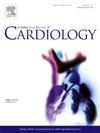Unveiling the limitations of non-metabolic thresholds in assessing maximal effort: The role of cardiopulmonary exercise testing
IF 3.2
2区 医学
Q2 CARDIAC & CARDIOVASCULAR SYSTEMS
引用次数: 0
Abstract
Introduction
Maximal effort, defined by a respiratory exchange ratio (RER) ≥ 1.10, is crucial for accurate interpretation of cardiopulmonary exercise testing (CPET). Standard tests rely on non-metabolic thresholds, such as peak predicted heart rate (ppHR) ≥ 85 %, double product (DP) ≥ 20,000 bpm*mmHg and peak metabolic equivalent of task (MET) ≥ 5.0. This study aimed to assess the effectiveness of non-metabolic thresholds in detecting maximal effort, compared with the RER ≥ 1.10 criterion.
Methods
We retrospectively analyzed stable patients who underwent CPET from 2022 to 2023, regardless of test indication, history of heart failure (HF), or medication use. All patients also performed transthoracic echocardiography.
Results
Among 239 middle-aged patients (53 ± 14 years, 67 % male), 86 % achieved a RER ≥ 1.10, and 65 % had a diagnosis of HF. Non-metabolic thresholds correctly identified maximal efforts (RER ≥ 1.10) in 75 % of the cases (AUC < 0.600). Misclassified cases were more likely to have a history of atrial fibrillation (AF), paced rhythm, HF, and beta-blockers or RAAS inhibitors use. These patients exhibited lower VO2 peak and higher VE/VCO2 slope. Multivariable analysis identified HF history (OR 4.8, CI 95 % 1.6–15.6, p: 0.005), low resting DP (≤ 7500 mmHg*bpm), and ramp protocol as independent predictors of discordant tests.
Conclusion
Non-metabolic thresholds misclassified up to 25 % of tests with RER ≥ 1.10 as non-maximal, potentially leading to inaccurate interpretation. In patients with HF, poor expected functional capacity and low DP, direct referral to CPET-equipped facilities may provide more accurate assessment than relying on non-metabolic thresholds.

揭示非代谢阈值在评估最大努力中的局限性:心肺运动试验的作用
由呼吸交换比(RER)≥1.10定义的最大努力对于准确解释心肺运动试验(CPET)至关重要。标准测试依赖于非代谢阈值,如峰值预测心率(ppHR)≥85%,双产物(DP)≥20,000 bpm*mmHg和峰值任务代谢当量(MET)≥5.0。本研究旨在评估非代谢阈值在检测最大努力方面的有效性,并与RER≥1.10标准进行比较。方法回顾性分析2022年至2023年接受CPET治疗的稳定患者,无论其检查指征、心力衰竭(HF)史或药物使用情况。所有患者还进行了经胸超声心动图检查。结果239例中年患者(53±14岁,男性67%)中,86%达到RER≥1.10,65%诊断为心衰。非代谢阈值在75%的病例中正确识别最大努力(RER≥1.10)(AUC <;0.600)。错误分类的病例更有可能有心房颤动(AF)、心律失常、心衰和β受体阻滞剂或RAAS抑制剂的使用史。这些患者表现出较低的VO2峰值和较高的VE/VCO2斜率。多变量分析确定HF病史(OR 4.8, CI 95% 1.6-15.6, p: 0.005)、低静息DP(≤7500 mmHg*bpm)和斜坡方案是不一致试验的独立预测因素。结论非代谢阈值将高达25%的RER≥1.10的试验误分类为非最大值,可能导致不准确的解释。对于心衰、预期功能能力差和DP低的患者,直接转诊到配备cpet的机构可能比依赖非代谢阈值提供更准确的评估。
本文章由计算机程序翻译,如有差异,请以英文原文为准。
求助全文
约1分钟内获得全文
求助全文
来源期刊

International journal of cardiology
医学-心血管系统
CiteScore
6.80
自引率
5.70%
发文量
758
审稿时长
44 days
期刊介绍:
The International Journal of Cardiology is devoted to cardiology in the broadest sense. Both basic research and clinical papers can be submitted. The journal serves the interest of both practicing clinicians and researchers.
In addition to original papers, we are launching a range of new manuscript types, including Consensus and Position Papers, Systematic Reviews, Meta-analyses, and Short communications. Case reports are no longer acceptable. Controversial techniques, issues on health policy and social medicine are discussed and serve as useful tools for encouraging debate.
 求助内容:
求助内容: 应助结果提醒方式:
应助结果提醒方式:


